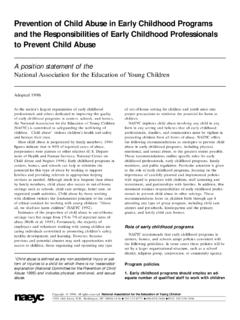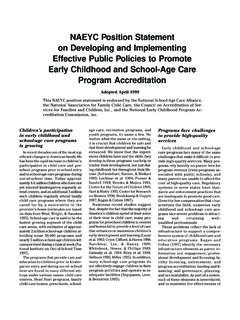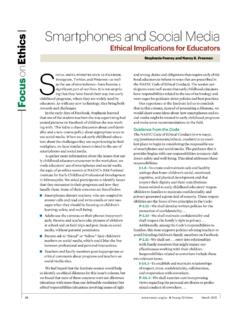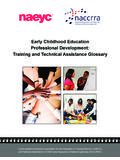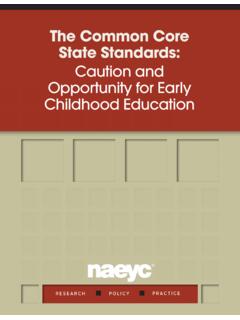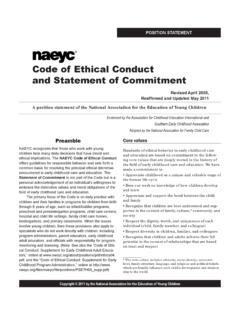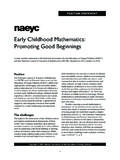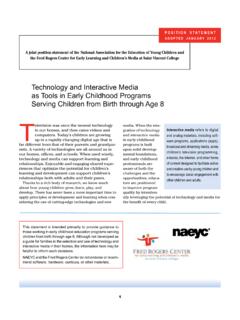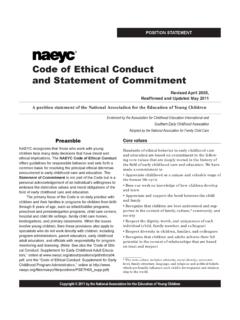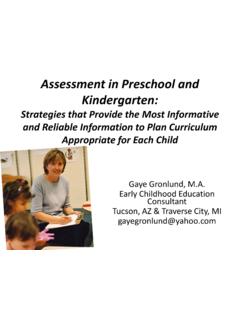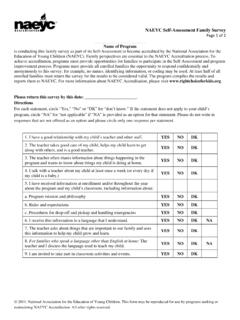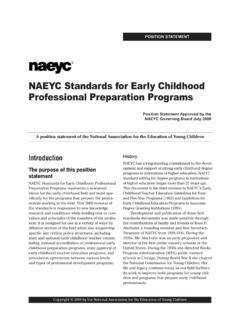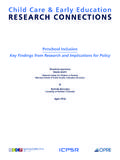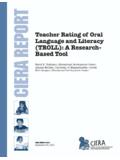Transcription of 2010 NAEYC Standards for Initial & Advanced Early ...
1 2010 NAEYC Standards for Initial & Advanced Early childhood professional preparation programs For use by Associate, Baccalaureate and Graduate Degree programs NAEYC / National Association for the Education of Young Children 1313 L St. NW, Suite 500, Washington, 20005. NAEYC professional preparation StandardsSeptember 20122011 National Association for the Education of Young Children, All Rights Reserved1 INTRODUCTION: THE PURPOSE AND USE OF THE NAEYC professional preparation Standards ..9 Standards AS A VISION OF 9 Unifying themes for the field across preparation levels, roles and settings.
2 9 Use in NAEYC Recognition and Accreditation of Higher Education programs .. 10 DEFINING professional preparation IN Early childhood EDUCATION .. 11 Multiple professional roles and pathways .. 11 Core values in professional preparation .. 12 To be an excellent teacher: professional preparation as meaning 12 RESPONDING TO CURRENT CHALLENGES, NEEDS AND OPPORTUNITIES .. 13 Diversity, inclusion and inequity .. 13 preparation across the birth-through-age 8 age range .. 14 Faculty development .. 14 Diversity in the teaching workforce and the growing role of community colleges in teacher education .. 15 Transfer and articulation: meeting immediate needs while keeping doors open.
3 16 Institutional and policy supports .. 17 DEVELOPMENT OF THE NAEYC Standards ..18 NAEYC S DEVELOPMENT AND REVISION PROCESS .. 18 NAEYC Position Statements .. 18 History .. 18 The Revisions process .. 19 Potential overlap with other SPA Standards .. 19 NAEYC professional preparation StandardsSeptember 20122011 National Association for the Education of Young Children, All Rights Reserved2 WHAT IS DIFFERENT IN THE 2010 NAEYC Initial AND Advanced Standards .. 20 A strengthened emphasis on academic content, diversity, inclusion, technology and Early childhood 20 Alignment with the 2009 SASB Principles .. 21 Strengthened Early childhood professional preparation across the full developmental age range, from birth through age 8.
4 21 Reorganization of the 2002 Advanced Essential professional Tools .. 22 Required field experiences in at least two age groups and at least two Early educational 22 ORGANIZATION OF THE 23 STUDYING THE Standards .. 23 Components of the Standards .. 23 Terminology .. 24 MEETING NAEYC Standards .. 26 An evidence based program report .. 26 A focus on assessments and data .. 26 Preponderance of the evidence policy .. 26 Understanding developmentally appropriate theory and practice .. 27 Meeting Advanced Standards .. 27 Innovation, risk and system development in Early childhood education .. 27 Initial Standards SUMMARY.
5 29 STANDARD 1. PROMOTING CHILD DEVELOPMENT AND LEARNING .. 29 Key elements of Standard 1 .. 29 NAEYC professional preparation StandardsSeptember 20122011 National Association for the Education of Young Children, All Rights Reserved3 Supporting explanation .. 29 STANDARD 2. BUILDING FAMILY AND COMMUNITY RELATIONSHIPS .. 30 Key elements of Standard 2 .. 30 Supporting explanation .. 31 STANDARD 3. OBSERVING, DOCUMENTING, AND ASSESSING TO SUPPORT YOUNG CHILDREN AND FAMILIES .. 32 Key elements of Standard 3 .. 32 Supporting explanation .. 32 STANDARD 4. USING DEVELOPMENTALLY EFFECTIVE APPROACHES .. 34 Key elements of Standard 4.
6 34 Supporting explanation .. 34 STANDARD 5. USING CONTENT KNOWLEDGE TO BUILD MEANINGFUL CURRICULUM . 36 Key elements of Standard 5 .. 36 Supporting explanation .. 36 STANDARD 6. BECOMING A professional .. 39 Key elements of Standard 6 .. 39 Supporting explanation .. 39 STANDARD 7. Early childhood FIELD EXPERIENCES .. 41 Key elements of Standard 7 .. 41 Supporting explanation .. 41 Suggested program chart of field experiences .. 43 Advanced Standards SUMMARY .. 44 NAEYC professional preparation StandardsSeptember 20122011 National Association for the Education of Young Children, All Rights Reserved4 LEADERSHIP IN Early childhood EDUCATION: THE ROLE OF Advanced professional preparation .
7 44 Meeting the NAEYC Advanced Standards .. 44 Features of all strong Advanced programs .. 44 Early childhood as a strongly interdisciplinary, collaborative, and systems-oriented profession .. 45 Highly dynamic, developmental, and policy-relevant nature of the Early childhood field .. 45 Diversity and focus in Early childhood professional settings and roles .. 46 Diversity of pathways bringing candidates into Advanced Early childhood programs 46 Highly dynamic, developmental, and policy-relevant nature of the Early childhood field .. 46 SPECIALIZED OF AREAS OF FOCUS .. 47 Early childhood accomplished teacher.
8 47 Early childhood administrator .. 47 Early childhood public policy and advocacy specialist .. 48 Early childhood teacher educator/researcher .. 48 NAEYC STANDARD 1. PROMOTING CHILD DEVELOPMENT AND LEARNING .. 48 Key elements of Standard 1, Advanced programs .. 48 Supporting explanation .. 49 NAEYC STANDARD 2. BUILDING FAMILY AND COMMUNITY RELATIONSHIPS .. 50 Key elements of Standard 2, Advanced programs .. 50 Supporting explanation .. 50 NAEYC STANDARD 3. OBSERVING, DOCUMENTING, AND ASSESSING TO SUPPORT YOUNG CHILDREN AND FAMILIES .. 51 Key elements of Standard 3, Advanced programs .. 51 NAEYC professional preparation StandardsSeptember 20122011 National Association for the Education of Young Children, All Rights Reserved5 Supporting explanation.
9 51 NAEYC STANDARD 4. USING DEVELOPMENTALLY EFFECTIVE APPROACHES TO CONNECT WITH CHILDREN AND FAMILIES .. 53 Key elements of Standard 4, Advanced programs .. 53 Supporting Explanation .. 53 NAEYC STANDARD 5. USING CONTENT KNOWLEDGE TO BUILD MEANINGFUL CURRICULUM .. 54 Key elements of Standard 5, Advanced programs .. 54 Supporting explanation .. 55 NAEYC STANDARD 6. GROWING AS A professional .. 56 Key elements of Standard 6, Advanced programs .. 56 Supporting explanation .. 56 STANDARD 7. Early childhood FIELD EXPERIENCES .. 57 Key elements of Standard 7, Advanced programs .. 58 Supporting explanation .. 58 Suggested program chart of field experiences.
10 60 REFERENCES .. 61 REFERENCES: INTRODUCTION .. 61 REFERENCES: STANDARD 1: PROMOTING CHILD DEVELOPMENT AND LEARNING .. 63 REFERENCES: STANDARD 2: BUILDING FAMILY AND COMMUNITY RELATIONSHIPS .. 64 REFERENCES: STANDARD 3: OBSERVING, DOCUMENTING, AND ASSESSING TO SUPPORT YOUNG CHILDREN AND FAMILIES .. 65 NAEYC professional preparation StandardsSeptember 20122011 National Association for the Education of Young Children, All Rights Reserved6 REFERENCES: STANDARD 4: USING DEVELOPMENTALLY EFFECTIVE APPROACHES TO CONNECT WITH CHILDREN AND FAMILIES .. 66 REFERENCES: STANDARD 5: USING CONTENT KNOWLEDGE TO BUILD MEANINGFUL CURRICULUM.
